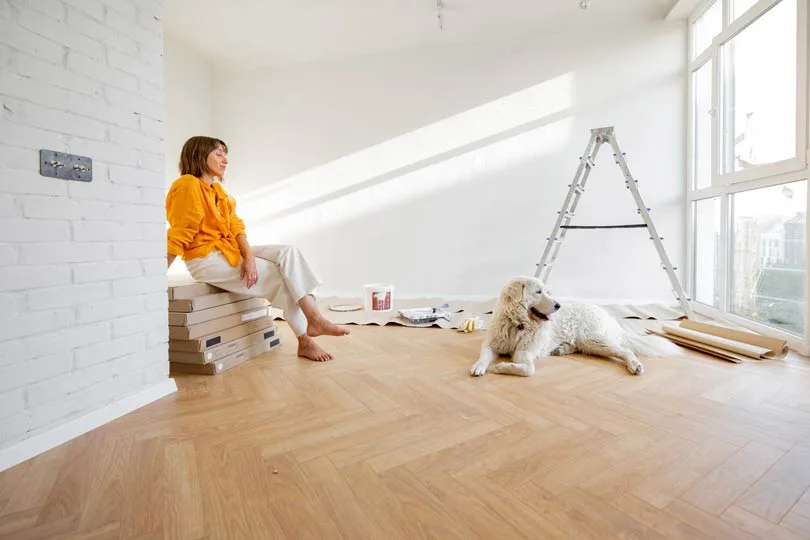Preparing your home beforehand is crucial to ensure a smooth and hassle-free process if you’re planning to embark on a flooring installation project. Proper preparation includes selecting appropriate materials and clearing the work area. A well-prepared home is the foundation of a successful flooring installation. This blog post will guide you through the essential steps to prepare your home for a seamless flooring installation experience.
1. Choose the Right Flooring Material:
When you’re planning to install new flooring in your home, one of the most important things to consider is the type of material you want to use. Many options are available, each with its own set of benefits and drawbacks. Before you start the preparation process, take some time to research and compare different types of flooring materials based on factors such as durability, maintenance requirements, and aesthetic preferences.
For example, if you have young children or pets, you might choose a flooring material that is easy to clean and resistant to scratches and stains. On the other hand, if you’re looking for a more luxurious or elegant look, you might prefer a material like hardwood or marble.
To make the best decision for each space in your home, it’s always a good idea to consult with flooring professionals. They can provide valuable insights and recommendations based on their experience and expertise and help you choose the suitable material that fits your needs and budget. Selecting the suitable flooring material ensures your new floors will be functional and beautiful for years.
2. Measure and Order Sufficient Materials:
Accurate measurements are crucial to ensure you order the right amount of flooring materials. Measure each room carefully, accounting for any extra footage needed for cuts and potential mistakes. Order additional materials to have a buffer in case of unexpected issues or future repairs.
3. Clear the Space:
Start the preparation process by clearing the space where the flooring installation will take place. Remove furniture, decor, and any items that might obstruct the installers. This streamlines the installation process and protects your belongings from potential damage.
4. Remove Old Flooring:
If you have existing flooring, decide whether it needs to be removed before the new installation. In some cases, it’s possible to install new flooring over the existing one, but this depends on the material and condition of the current floor. Ensure a smooth and clean surface for the new installation.
5. Address Subfloor Issues:
Examine the subfloor for any issues that might affect the installation. Uneven surfaces, squeaks, or damage should be addressed before laying the new flooring. Consult with professionals to ensure the subfloor is in optimal condition for the chosen material.
6. Check for Moisture and Humidity:
Certain flooring materials, such as hardwood, are sensitive to moisture. Check the subfloor’s humidity levels and moisture content to prevent potential issues like warping or cupping. Use a moisture meter and, if necessary, implement measures like moisture barriers.
7. Plan for Waste Disposal:
Flooring installations generate waste, including old materials and packaging from the new flooring. Plan proper waste disposal by renting a dumpster or coordinating with local waste management services. This helps keep the installation area organized and safe.
8. Create a Comfortable Workspace for The Flooring Installers:
Consider the well-being of the installers by providing a comfortable workspace. Ensure access to electrical outlets, water, and restroom facilities. Clear pathways for easy movement and communicate specific house rules or safety considerations.
9. Secure Pets and Children:
Flooring installations can be noisy and involve potentially hazardous tools and materials. For the safety of your pets and children, consider securing them in a separate area or arranging for them to stay elsewhere during installation.
10. Communicate with Flooring Installers:
Open communication with the flooring installers is crucial. Discuss any specific concerns, timelines, and expectations before the project begins. Ensure everyone is on the same page to avoid misunderstandings and facilitate a smoother installation process.
Properly preparing your home for a flooring installation is crucial to ensuring a successful and stress-free project. It involves several important considerations that must be considered to achieve the desired results. Firstly, you must choose suitable materials that match your style, budget, and needs. This involves researching different types of flooring, such as hardwood, laminate, tile, or vinyl, and weighing their pros and cons. You may also want to consult a flooring expert or contractor for their advice and recommendations.
Once you have selected your flooring materials, you must prepare the space where the installation will occur. This includes removing existing flooring, furniture, and other obstacles that may hinder installation. You should also ensure that the subfloor is level, clean, and dry, as this will help to prevent any issues with the flooring later on. Additionally, you may need to make minor repairs or adjustments to the subfloor to ensure it is in good condition.
Another critical aspect of preparing your home for a flooring installation is creating a comfortable workspace for the installers. This involves ensuring the space is well-lit, ventilated, and free from distractions or hazards. It would help if you also ensured that the installers have easy access to the space and any tools or equipment they may need to complete the job.
By following these steps and properly preparing your home for a flooring installation, you can contribute to a seamless process that leaves you with a beautiful, professionally installed floor for years.



